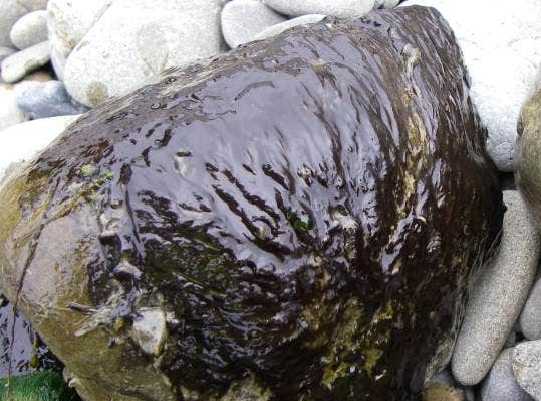The Otago Regional Council (ORC) is asking dog owners to learn how to recognise potentially toxic algal mats in rivers, in order to keep their pets safe this summer.
Phormidium, a naturally occurring algae, thrives in Otago rivers during summer – particularly the Cardrona, Hawea and Manuherekia Rivers, but it has also been spotted in other parts of the region, such as the Waianakarua River and Silver Stream.
Phormidium forms thick dark brown mats on rocks in the riverbed and can sometimes look like black tar. In the flow of water, phormidium mats detach from the riverbed and wash up on riverbanks. Its musty smell is particularly attractive to dogs and, if eaten, phormidium can result in severe poisoning or death.
“We haven’t had any reported sightings of phormidium so far this season, but we want to remind dog owners to stay vigilant whenever their dog is near water”, said Helen Manly, ORC Team Leader Water in the Science team.
“The warm conditions we’re expecting to see with this being a La Niña summer will provide ideal conditions for potentially toxic algae blooms. Don’t wait for a warning sign – if you’re taking dogs anywhere near a riverbank, keep them on a lead and well clear of washed up phormidium mats along the riverbed.”
While ORC monitors bacteria levels at swimming spots, potentially toxic algae can emerge anywhere along rivers so it’s not part of an active monitoring programme.
Any person – or dog – who may have had contact with toxic algae, should rinse off with fresh water as soon as possible.
Anyone experiencing a reaction from contact with toxic algae should seek urgent medical attention, and any signs a dog has been poisoned by toxic algae (lethargy, muscle tremors, fast breathing, twitching, paralysis and convulsion) should be treated as an emergency and referred to a vet immediately.
“The best thing to do is be aware of your surroundings, learn how to identify potentially toxic algae, steer well clear of it and keep your dog on a lead and out of the water,” said Ms Manly.
To learn more about potentially toxic algae, including how to identify algal blooms in rivers and lakes, see the LAWA factsheet: https://www.lawa.org.nz/learn/factsheets/potentially-toxic-algae/
To report algal blooms in Otago lakes and rivers, contact the pollution hotline: 0800 800 033.

A dark brown phormidium mat. Source: Northland Regional Council
